
Wine Culture and Information since 2002 - Volume 22
 Wine Culture and Information since 2002 - Volume 22 |
|
Comparing Sagrantino di Montefalco PassitoAmong the most famous red berried grapes of Italy and among the richest in polyphenols, Sagrantino is a grape from Umbria and today used both for dry and sweet wines |
|
Sagrantino certainly is among the most renowned grapes of Italy, also very successful in the world. A grape with a high content in polyphenols, Sagrantino is an autochthonous variety from Umbria, more specifically from Montefalco, in the province of Perugia, where it is the protagonist of the wines of this area since centuries. Despite today Sagrantino di Montefalco is mainly known as a dry wine, in the past the grape was allowed to dry in mats and exclusively used for the production of a sweet wine, with a strong tannic and astringent character. In Montefalco, sweet Sagrantino was mainly consumed in occasion of the Easter lunch - therefore a wine for holidays and special occasions - matched to the traditional roasted lamb. This tradition radically changes in the beginning of the 1970s, when it was produced the first dry Sagrantino: a success which distinguishes Montefalco in the world still today. Sagrantino is considered as an autochthonous grape of Montefalco, however its origins are not clear. According to some, Sagrantino was introduced by some Franciscan monks around the fourteenth or fifteenth century, according to others, the grape is from Spain and introduced in Montefalco by Saracens. Researches done in Sagrantino's DNA did not find any genetic analogy with other varieties, a condition which further increases the mystery of the origin of this noble Umbrian grape and strengthen the hypothesis it is an autochthonous variety of Montefalco. Also the origin of the grape's name is pretty uncertain. The most common hypothesis is that the name comes from the Latin sacer, that is sacred, something which is referred to the probable use of Sagrantino in ancient times, that is consumed in occasion of holidays and sacred liturgies, a custom which could also be dated back to the times of ancient Rome. This hypothesis could also be confirmed by the local and ancient tradition of consuming sweet Sagrantino in occasion of Easter, matched with the traditional roasted lamb.
|
|
Sagrantino is among the red berried grapes having the highest content in polyphenols, therefore its wines - both in the dry style and in the sweet style - are characterized by an evident astringency and a remarkable structure. Tannins are in fact one of the most important preoccupations for Sagrantino producers, as they need to put extreme attention on the phenolic ripeness of grapes, as well as to properly age the wine in wood, in order to mitigate this strong aspect of the wine and to make it rounder. The production of Sagrantino di Montefalco Passito provides for the drying of the grapes in proper rooms, where the bunches are placed on mats in order to allow a proper loss of water and a concentration of the substances contained in the berries. According to production disciplinary, Sagrantino di Montefalco Passito can be commercialized only after 30 months of aging in producer's cellars, it must have an alcohol by volume not lesser than 14.5% and a minimum of residual sugars of 30 grams per liters.
The aging of Sagrantino di Montefalco Passito can be done both in cask and in barrique. The wines selected for our comparative tasting are all aged in cask, therefore favoring - in this case - the organoleptic qualities of Sagrantino. The first wine selected for our tasting is Antonelli's Sagrantino di Montefalco Passito, aged for 15 months in cask, 3 months in cement tanks and then for 12 months in bottle. The second wine is Adanti's Sagrantino di Montefalco Passito, also in this case aged in cask, although for a longer period of 24 months. The last wine of the tasting is Tabarrini's Sagrantino di Montefalco Passito Colle Grimaldesco, aged in cask but for a longer period, more than 24 months. The wines will be selected in the current commercialized vintage and they will be tasted at the temperature of 16°C (60°F), in order to properly limit the perception of sweetness, without making the wine excessively astringent. The wines will be poured, as usual, in three ISO tasting glasses.
|
||||||||
|
As already mentioned, Sagrantino is a grape with a high content in polyphenols - therefore of coloring substances - a quality which evidently affects both color and transparency of its wines, either dry or sweet. Sagrantino di Montefalco is characterized in the aspect by very intense and deep colors and a pretty reduced transparency, qualities which are more evident in the sweet style. Sagrantino di Montefalco Passito's color is generally deep ruby red, with ruby red or garnet red nuances. Transparency is very low, most of the times impenetrable to light, a sign of the remarkable concentration produced both by the drying of grapes and the high content in coloring substances. With time, the color of Sagrantino passito will develop in garnet red, while continuing to show in the nuances, thanks to its remarkable longevity in bottle, an evident garnet red color. The first wine of which we will examine appearance is Antonelli's Sagrantino di Montefalco Passito. By holding the glass tilted over a white surface - a sheet of paper is enough - we will evaluate, at the base of the glass, the color of the wine. It will be noticed an evident intense ruby red color and a pretty low transparency, whereas, by observing the edge of the wine, towards the opening of the glass, will be noticed garnet red nuances. The aspect of the second wine - Adanti's Sagrantino di Montefalco Passito - is characterized by a deep ruby red color, deeper than the previous wine, with a very low transparency, whereas the nuances will have a garnet red color. Also the aspect of the third wine, Tabarrini's Sagrantino di Montefalco Passito Colle Grimaldesco, is characterized by a deep ruby red color and a very low transparency, with garnet red nuances, not very different from the previous wine.
|
|
Sagrantino generally is a grape very generous to the nose: its intense aromas of flowers and fruits, as well as more complex aromas developed with time and with the aging, gives the taster an interesting sensorial experience. In the case of Sagrantino di Montefalco Passito, the aromatic qualities usually are more accentuated and mature, offering more concentrated and complex sensations than the dry style. Among the typical fruit aromas of Sagrantino di Montefalco Passito, are mentioned blackberry, black cherry and plum - sometimes also in form of jams - that together with violet and dried violet, make the identifying qualities of the wine. Thanks to the aging in cask, in its 30 months of aging, Sagrantino di Montefalco Passito develops complex aromas, fruits aromas usually develop characteristic of jams and to the nose can also be perceived aromas of cocoa, chocolate, nail polish, carob, vanilla, cinnamon, tobacco, licorice, mace, pink pepper, star anise and clover, as well as balsamic sensations of eucalyptus and menthol. The phase of aroma evaluation of our comparative tasting will begin from Antonelli's Sagrantino di Montefalco Passito. By holding the glass in vertical position and without swirling, we will proceed with the first smell in order to perceive the opening aromas of the wine, that is the aromatic qualities identifying a wine and which volatilize with a small quantity of oxygen. From the glass will be perceived intense, clean and pleasing aromas of blackberry, plum and black cherry, a typical opening of Sagrantino, in particular the aroma of blackberry. After having swirled the glass - in order to favor the volatilization of heavier aromas - we will tilt the glass and we will bring it to the nose, proceeding with the second smell, therefore completing the olfactory profile of the first wine. From the glass will be perceived aromas of blueberry and violet, followed by more complex aromas of vanilla, chocolate, tobacco and mace, as well as a pleasing balsamic touch of menthol. We will proceed now with the evaluation of the second wine of our comparative tasting: Adanti's Sagrantino di Montefalco Passito. The opening of this Sagrantino is characterized, like the previous wine, by intense, clean and pleasing aromas of blackberry, plum and black cherry, the typical identifying qualities of this wine. After having swirled the glass, we will proceed with the second smell which will complete the olfactory profile of the wine with aromas of dried violet, blueberry, vanilla, chocolate, tobacco, cinnamon, star anise and mace, as well as hints of lavender and menthol. Also the opening of the third wine - Tabarrini's Sagrantino di Montefalco Passito Colle Grimaldesco di Tabarrini - is characterized by blackberry, black cherry and plum, very intense and concentrated. By proceeding with the second smell, the profile of the wine will be completed with aromas of dried violet, blueberry, vanilla, tamarind, cocoa, tobacco, pink pepper, cinnamon, dried fig, caramel, mace, coconut and the usual balsamic touch of menthol.
|
||||
|
Because of its high content in polyphenolic substances, wines produced with Sagrantino grape - both dry and sweet - are characterized by a pretty evident and aggressive astringency. These gustatory qualities require the presence of other component in order to balance the tannic strength of Sagrantino, in particular the roundness given by the aging in wood and time, as well as a proper quantity of alcohol. It is not by chance the alcohol by volume of Sagrantino di Montefalco Passito is generally greater than 14.5%, a parameter which - among the other things - is also set as the minimum value by the production disciplinary. The astringency and the burning sensation of alcohol is accompanied, as we can clearly expect from a wine of this kind, by an evident sweetness which contributes, after the initial wonder, to make Sagrantino balanced. The combination astringency-sweetness, so unusual in sweet wines, contributes to the formation of the personality and character of Sagrantino di Montefalco Passito. Let's begin the gustatory evaluation of the wines of our comparative tasting from Antonelli's Sagrantino di Montefalco Passito. The attack of this first wine - that is the initial sensation perceived in the mouth at the first sip and without swallowing the wine - is characterized by an evident sweetness accompanied by an evident astringency, promptly balanced by alcohol, and a very robust structure. The evaluation of the second wine - Adanti's Sagrantino di Montefalco Passito - is not so different from the previous wine: a tannic and sweet attack, a very robust structure which is balanced by the contribution of alcohol. The last wine of our comparative tasting - Tabarrini's Sagrantino di Montefalco Passito Colle Grimaldesco - does not contradict the typical personality of the wine, with a tannic and sweet attack, while leaving a space for the balance obtained from the contribution of alcohol, a robust structure and a sensation of concentrated and thick flavors. It should be noticed, in all the three wines, the excellent correspondence to the nose with the aromas of blackberry, plum and black cherry.
|
|
Rich, thick, concentrated, robust and very good taste-olfactory persistence: these are the sensations which can be perceived in the final phase of the tasting of Sagrantino di Montefalco Passito. The finish of Antonelli's Sagrantino di Montefalco Passito is persistent, leaving in the mouth intense and clean flavors of blackberry, black cherry and plum, as well as an evident sensation of structure. The finish of Adanti's Sagrantino di Montefalco Passito is persistent with long and intense flavors of blackberry, plum and black cherry, a sensation of structure more robust than the previous wine. The finish of the last wine - Tabarrini's Sagrantino di Montefalco Passito Colle Grimaldesco - is very persistent, also in this case with a very robust sensation of structure, as well as intense, clean and long flavors of blackberry, black cherry and plum with a hint of tamarind. It should be noticed, in all the three wines, how the use of wood does not excessively influence the taste of Sagrantino, leaving space to the fruit qualities of the grape.
|
Wines of the Month |
|
|
|
Score legend Prices are to be considered as indicative. Prices may vary according to the country or the shop where wines are bought |

|
|
Nispero 2005 |
|
| Adanti (Umbria, Italy) | |
| Grapes: Sangiovese (85%), Merlot (10%), Barbera (5%) | |
| Price: € 6.00 | Score: |
| Nispero shows a brilliant ruby red color and nuances of garnet red, moderate transparency. The nose reveals intense, clean and pleasing aromas that start with hints of black cherry, plum and violet followed by aromas of strawberry, blueberry, cinnamon and vanilla. The mouth has good correspondence to the nose, a tannic attack and pleasing crispness, however balanced by alcohol, good body, intense flavors. The finish is persistent with flavors of black cherry, plum and strawberry. Nispero ages for 6 months in cask. | |
| Food Match: Sauteed meat, Stewed meat with mushrooms, Broiled meat and barbecue | |
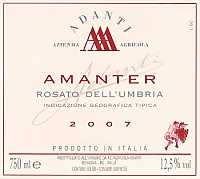
|
|
Amanter 2007 |
|
| Adanti (Umbria, Italy) | |
| Grapes: Sangiovese, Sagrantino | |
| Price: € 7.00 | Score: |
| Amanter shows a brilliant cherry pink color and nuances of onion skin pink, transparent. The nose denotes intense, clean and pleasing aromas that start with hints of cherry, raspberry and cyclamen followed by aromas of blueberry, plum and blackberry. The mouth has good correspondence to the nose, a crisp attack and however balanced by alcohol, good body, intense flavors. The finish is persistent with flavors of cherry, raspberry and plum. Amanter ages in steel tanks. | |
| Food Match: Pasta with meat, Roasted fish, Roasted white meat, Cold cuts | |
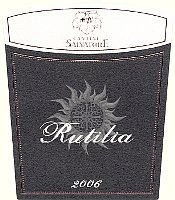
|
|
Rutilia 2006 |
|
| Cantine Salvatore (Molise, Italy) | |
| Grapes: Tintilia | |
| Price: € 12.50 | Score: |
| Rutilia shows an intense ruby red color and nuances of ruby red, little transparency. The nose reveals intense, clean, pleasing and refined aromas that start with hints of blackberry, black cherry and plum followed by aromas of violet, raspberry, blueberry and cyclamen. The mouth has good correspondence to the nose, a tannic attack and however balanced by alcohol, good body, intense flavors. The finish is persistent with flavors of blackberry, plum and black cherry. Rutilia ages for 18 months in steel tanks. | |
| Food Match: Broiled meat and barbecue, Stewed meat with mushrooms, Roasted meat | |
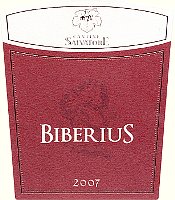
|
|
Molise Rosso Biberius 2007 |
|
| Cantine Salvatore (Molise, Italy) | |
| Grapes: Montepulciano | |
| Price: € 8.50 | Score: |
| Molise Rosso Biberius shows an intense ruby red color and nuances of purple red, little transparency. The nose denotes intense, clean, pleasing and refined aromas which start with hints of black cherry, blackberry and plum followed by aromas of blueberry, violet, raspberry, geranium, cyclamen and pink pepper. The mouth has good correspondence to the nose, a tannic attack and however balanced by alcohol, good body, intense flavors, pleasing crispness. The finish is persistent with flavors of black cherry, blackberry and plum. Molise Rosso Biberius ages for 8 months in steel tanks. | |
| Food Match: Pasta with meat and mushrooms, Stewed meat, Broiled meat and barbecue | |

|
|
Dolcetto d'Alba Bricco Caramelli 2007 |
|
| Mossio (Piedmont, Italy) | |
| Grapes: Dolcetto | |
| Price: € 9.80 | Score: |
| Dolcetto d'Alba Bricco Caramelli shows a intense ruby red color and nuances of purple red, little transparency. The nose reveals intense, clean, pleasing, refined and elegant aromas which start with hints of cherry, blackberry and plum followed by aromas of violet, peach, raspberry, blueberry, cyclamen, anise and strawberry. The mouth has good correspondence to the nose, a tannic attack and however balanced by alcohol, good body, intense flavors, pleasing crispness. The finish is persistent with flavors of cherry, plum and blackberry. A well made wine. Dolcetto d'Alba Bricco Caramelli ages in steel tanks. | |
| Food Match: Cold cuts, Pasta with meat and mushrooms, Roasted white meat, Sauteed meat | |
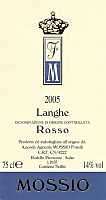
|
|
Langhe Rosso 2005 |
|
| Mossio (Piedmont, Italy) | |
| Grapes: Nebbiolo, Barbera, Dolcetto | |
| Price: € 13.30 | Score: |
| This Langhe Rosso shows a brilliant ruby red color and nuances of ruby red, little transparency. The nose reveals intense, clean, pleasing, refined and elegant aromas which start with hints of cherry, plum and raspberry followed by aromas of violet, blueberry, vanilla, rose, cinnamon, chocolate, cinnamon and menthol. The mouth has good correspondence to the nose, a tannic attack and pleasing crispness, however balanced by alcohol, good body, intense flavors, pleasing roundness. The finish is persistent with flavors of cherry, plum and raspberry. A well made wine. This Langhe Rosso ages in cask. | |
| Food Match: Roasted meat, Braised and stewed meat, Hard cheese | |
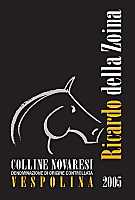
|
|
Colline Novaresi Vespolina Ricardo della Zoina 2005 |
|
| Cascina Zoina (Piedmont, Italy) | |
| Grapes: Vespolina | |
| Price: € 8.00 | Score: |
| Colline Novaresi Vespolina Ricardo della Zoina shows a brilliant ruby red color and nuances of ruby red, moderate transparency. The nose denotes intense, clean and pleasing aromas which start with hints of cherry, plum and raspberry followed by aromas of pomegranate, vanilla, cyclamen and black pepper. The mouth has good correspondence to the nose, a slightly tannic attack and pleasing crispness, however balanced by alcohol, good body, intense flavors. The finish is persistent with flavors of black cherry, raspberry and plum. Colline Novaresi Vespolina Ricardo della Zoina ages for 12 months in barrique followed by 12 months of aging in bottle. | |
| Food Match: Stuffed pasta, Stewed meat with mushrooms, Broiled meat and barbecue | |
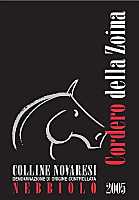
|
|
Colline Novaresi Nebbiolo Cordero della Zoina 2005 |
|
| Cascina Zoina (Piedmont, Italy) | |
| Grapes: Nebbiolo | |
| Price: € 8.00 | Score: |
| Colline Novaresi Nebbiolo Cordero della Zoina shows a brilliant ruby red color and nuances of garnet red, moderate transparency. The nose denotes intense, clean, pleasing and refined aromas which start with hints of cherry, plum and rose followed by aromas of raspberry, violet, strawberry, vanilla and menthol. The mouth has good correspondence to the nose, a tannic attack and pleasing crispness, however balanced by alcohol, good body, intense flavors. The finish is persistent with flavors of cherry, plum and raspberry. Colline Novaresi Nebbiolo Cordero della Zoina ages for 12 months in barrique, 4 months in steel tanks and for at least 12 months in bottle. | |
| Food Match: Broiled meat and barbecue, Roasted meat, Stewed meat with mushrooms | |
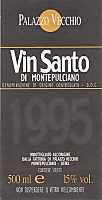
|
|
VinSanto di Montepulciano 1995 |
|
| Fattoria di Palazzo Vecchio (Tuscany, Italy) | |
| Grapes: Malvasia Bianca, Grechetto | |
| Price: € 42.00 - 500ml | Score: |
| This VinSanto di Montepulciano shows a brilliant amber yellow color and nuances of amber yellow, transparent. The nose reveals intense, clean, pleasing and refined aromas which start with hints of dried fig, citrus fruits peel and almond followed by aromas of apricot jam, plum jam, quince jam, candied fruits, vanilla, caramel, walnut and nail polish. The mouth has good correspondence to the nose, a sweet attack and pleasing crispness, however balanced by alcohol, good body, intense flavors, pleasing roundness. The finish is persistent with flavors of dried fig, quince jam and walnut. This VinSanto di Montepulciano ages in small oak barrels. | |
| Food Match: Confectionery, Almond tarts, Hard cheese | |
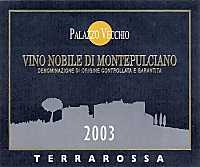
|
|
Vino Nobile di Montepulciano Terrarossa 2003 |
|
| Fattoria di Palazzo Vecchio (Tuscany, Italy) | |
| Grapes: Sangiovese Grosso | |
| Price: € 24.00 | Score: |
| Vino Nobile di Montepulciano Terrarossa shows a brilliant ruby red color and nuances of garnet red, little transparency. The nose reveals intense, clean, pleasing, refined and elegant aromas which start with hints of black cherry, plum and violet followed by aromas of raspberry, blueberry, blackberry, vanilla, tobacco, cocoa, mace and menthol. The mouth has good correspondence to the nose, a tannic attack and pleasing roundness, however balanced by alcohol, full body, intense flavors. The finish is persistent with flavors of black cherry, plum and blackberry. A well made wine. Vino Nobile di Montepulciano Terrarossa ages for 24 months in cask followed by 18 months of aging in bottle. | |
| Food Match: Game, Roasted meat, Braised and stewed meat, Hard cheese | |
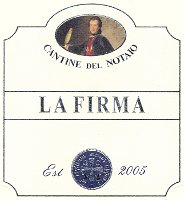
|
|
Aglianico del Vulture La Firma 2005 |
|
| Cantine del Notaio (Basilicata, Italy) | |
| Grapes: Aglianico | |
| Price: € 32.00 | Score: |
| Aglianico del Vulture La Firma shows an intense ruby red color and nuances of ruby red, little transparency. The nose reveals intense, clean, pleasing, refined and elegant aromas which start with hints of plum, blackberry and black cherry followed by aromas of violet, blueberry, raspberry, vanilla, tobacco, pink pepper, chocolate, mace and menthol. The mouth has good correspondence to the nose, a tannic attack and however balanced by alcohol, full body, intense flavors, pleasing roundness. The finish is very persistent with long flavors of blackberry, black cherry and plum. A well made wine. Aglianico del Vulture La Firma ages for 12 months in cask followed by 4 months of aging in bottle. | |
| Food Match: Game, Roasted meat, Stewed and braised meat, Hard cheese | |
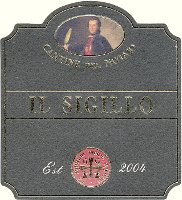
|
|
Aglianico del Vulture Il Sigillo 2004 |
|
| Cantine del Notaio (Basilicata, Italy) | |
| Grapes: Aglianico | |
| Price: € 36.00 | Score: |
| Aglianico del Vulture Il Sigillo shows a deep ruby red color and nuances of ruby red, little transparency. The nose reveals intense, clean, pleasing, refined and elegant aromas which start with hints of black cherry, blackberry and plum followed by aromas of black currant, blueberry, violet, vanilla, tobacco, chocolate, mace, clover, pink pepper and menthol. The mouth has good correspondence to the nose, a tannic attack and pleasing roundness, however balanced by alcohol, full body, intense flavors. The finish is very persistent with long flavors of blackberry, black cherry and plum. A well made wine. Aglianico del Vulture Il Sigillo ages for 24 months in barrique. | |
| Food Match: Game, Roasted meat, Braised and stewed meat, Hard cheese | |
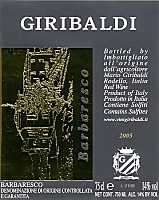
|
|
Barbaresco 2005 |
|
| Giribaldi (Piedmont, Italy) | |
| Grapes: Nebbiolo | |
| Price: € 26.00 | Score: |
| This Barbaresco shows a brilliant ruby red color and nuances of garnet red, moderate transparency. The nose denotes intense, clean, pleasing and refined aromas which start with hints of cherry, plum and violet followed by aromas of rose, raspberry, strawberry, vanilla, cinnamon, tobacco and mace. The mouth has good correspondence to the nose, a tannic attack and pleasing crispness, however balanced by alcohol, full body, intense flavors. The finish is persistent with flavors of cherry, plum and strawberry. This Barbaresco ages for more than 2 years in cask. | |
| Food Match: Game, Roasted meat, Braised and stewed meat, Hard cheese | |

|
|
Barolo 2004 |
|
| Giribaldi (Piedmont, Italy) | |
| Grapes: Nebbiolo | |
| Price: € 29.00 | Score: |
| This Barolo shows a brilliant ruby red color and nuances of garnet red, moderate transparency. The nose reveals intense, clean, pleasing and refined aromas that start with hints of cherry, plum and violet followed by aromas of raspberry, strawberry, rose, vanilla, pink pepper, cinnamon, cocoa and menthol. The mouth has good correspondence to the nose, a tannic attack and pleasing crispness, however balanced by alcohol, full body, intense flavors. The finish is persistent with flavors of cherry, plum and strawberry. This Barolo ages for more than 2 years in cask. | |
| Food Match: Game, Roasted meat, Braised and stewed meat, Hard cheese | |
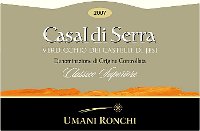
|
|
Verdicchio dei Castelli di Jesi Classico Superiore Casal di Serra 2007 |
|
| Umani Ronchi (Marches, Italy) | |
| Grapes: Verdicchio | |
| Price: € 10.00 | Score: |
| Verdicchio dei Castelli di Jesi Classico Superiore Casal di Serra shows a pale straw yellow color and nuances of greenish yellow, very transparent. The nose denotes intense, clean, pleasing and refined aromas which start with hints of pear, apple and plum followed by aromas of almond, citrus fruits, pineapple, hawthorn, peach and mineral. The mouth has good correspondence to the nose, a crisp attack and however balanced by alcohol, good body, intense flavors, agreeable. The finish is persistent with flavors of apple, plum and almond. Verdicchio dei Castelli di Jesi Classico Superiore Casal di Serra ages for 5 months in steel tanks. | |
| Food Match: Pasta with fish, Roasted white meat, Stewed fish, Broiled fish | |

|
|
Rosso Conero Riserva Cumaro 2005 |
|
| Umani Ronchi (Marches, Italy) | |
| Grapes: Montepulciano | |
| Price: € 20.00 | Score: |
| Rosso Conero Riserva Cumaro shows a deep ruby red color and nuances of ruby red, little transparency. The nose reveals intense, clean, pleasing, refined and elegant aromas that start with hints of black cherry, plum and black currant followed by aromas of violet, blueberry, blackberry, vanilla, tobacco, chocolate, cinnamon, clover and menthol. The mouth has good correspondence to the nose, a tannic attack and however balanced by alcohol, full body, intense flavors, pleasing roundness. The finish is persistent with flavors of black cherry, plum and black currant. A well made wine. Rosso Conero Riserva Cumaro ages for 14 months in barrique followed by 8 months of aging in bottle. | |
| Food Match: Game, Roasted meat, Braised and stewed meat, Hard cheese | |
|
||||||||
|
DiWineTaste Polls
|
| |||||||
Privacy Policy | |||||||


| Copyright © 2002-2024 Antonello Biancalana, DiWineTaste - All rights reserved |
| All rights reserved under international copyright conventions. No part of this publication and of this WEB site may be
reproduced or utilized in any form or by any means, electronic or mechanical, without permission in writing from DiWineTaste. |